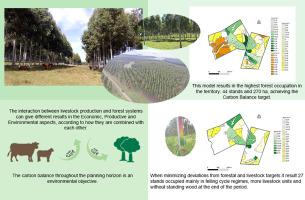Agricultural Systems ( IF 6.1 ) Pub Date : 2021-03-17 , DOI: 10.1016/j.agsy.2021.103118 Adriana Bussoni , Frederick Cubbage , Jorge Alvarez Giambruno

|
Context
Forestry production can provide a valuable commodity and environmental services to complement cattle farming through the mitigation of greenhouse gases (GHG) from meat production, allowing more intensive use of natural resources.
Objective
This study addressed the long-term integration of forestry and cattle farming to achieve productive, economic and environmental benefits.
Methods
It was applied Goal Programming and empirical field, cattle, and timber production data and farmer interviews of priorities were used to analyze integrated forestry production of Eucalyptus plantations and cattle breeding and rearing. The preemptive criteria applied were max Forest Net Present Value (NPV), max Cattle NPV, and Carbon Balance. Additionally goals were to minimize the deviation of a normal forest, among others.
Results and conclusions
A Type I lexicographical multi-criteria model was developed in three hierarchical models for a 408 ha model farm. Model M1 results in the higher combined NPV Cattle (302,935 US$) and NPV Forest (556,578 US$); Model M2, where NPV Cattle is prioritized at the first level, achieved the target of 317,307 US$ but the least success in achieving carbon positive balance with a negative balance of −20,160 tons of CO2-e released. Comparing the results of model M3, where minimizing the negative carbon balance, a positive carbon balance of +6788 tons CO2-e, in a scenario where the environmental goal would be imposed. The difference of NPV cattle between M2 and M3 is −24,609 US$. The environmental criterion must be allocated to higher hierarchical levels in order to achieve a positive balance and obtain profits from forest and cattle. This also allows quantification of how far removed a system is from achieving a goal of integrated and sustainable production. The lexicographical methodology allowed quantification of results as a function of the hierarchical allocation of various goals within different integration models through studying efficient subgroups.
Significance
It is shown that environmental and productive objectives can be integrated, even considering harvest of trees in the system achieving economic, environmental and productive goals in the medium or long term, with deviations that the decision maker can accept; plans can also be established with results that can serve as a policy guide, that provide for the incorporation of environmental services. Variations in the models showed the final solution is highly dependent on the preferences order in the higher level; the environmental goal is achievable if it is prioritized at a higher hierarchical level.
中文翻译:

席牧系统和多准则优化,以实现兼容的经济和环境成果
语境
林业生产可以提供有价值的商品和环境服务,通过减轻肉类生产中的温室气体(GHG)来补充牛牧业,从而可以更大量地利用自然资源。
客观的
这项研究解决了林业与养牛业的长期融合,以实现生产,经济和环境效益。
方法
应用了目标规划和实地数据,牛和木材生产数据以及农民对重点事项的访谈,以分析桉树人工林的综合林业生产以及牛的繁殖和饲养。应用的优先标准是最大森林净现值(NPV),最大牛NPV和碳平衡。另外的目标是最大程度地减少正常森林的偏差。
结果与结论
针对408公顷的模型农场,在三个层次模型中开发了I型字典多标准模型。型号中号1所导致更高的组合NPV牛(302935 US $)和NPV森林(556578 US $); 优先考虑NPV牛的模型M 2实现了317,307美元的目标,但实现负碳平衡(-20,160吨CO 2-e负排放)的成功最少。比较模型M 3的结果,该模型在要达到环境目标的情况下将负碳平衡最小化,将正碳平衡+6788吨CO 2- e。M之间NPV牛的区别2和M 3为-24,609美元。必须将环境标准分配给更高的等级,以实现积极的平衡并从森林和牲畜中获取利润。这也可以量化系统距离实现集成和可持续生产目标有多远。词典方法学通过研究有效的亚组,可以根据不同整合模型内各种目标的等级分配,对结果进行量化。
意义
结果表明,即使考虑到在中长期内实现经济,环境和生产目标的系统中的树木采伐,环境和生产目标也可以整合在一起,决策者可以接受。还可以制定计划,其结果可以用作政策指南,为纳入环境服务提供依据。模型的变化表明,最终的解决方案高度依赖于更高层次上的偏好顺序。如果在更高层次上将环境目标放在优先地位,则可以实现环境目标。











































 京公网安备 11010802027423号
京公网安备 11010802027423号